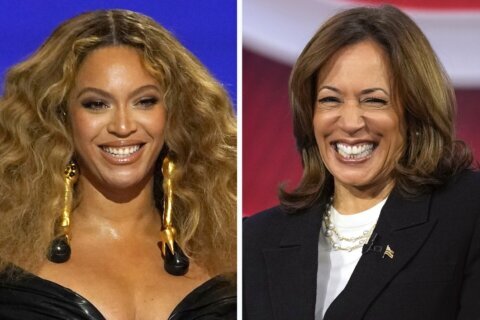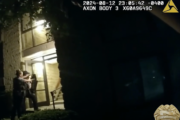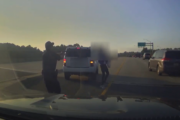WASHINGTON — In his filmmaking prime, he directed Best Pictures like “Braveheart” (1995) and phenomenons like “The Passion of the Christ” (2004).
Now, Mel Gibson delivers the World War II flick “Hacksaw Ridge” just in time for Veterans Day.
It’s a rousing return for Gibson after a decade of Hollywood exile over anti-Semitic comments made during a drunken rant in a police DUI video. Regardless of what you think of the man, it’s a major comeback for the filmmaker, whose more graphic impulses are trumped by the inspiring real events.
It follows the true story of Desmond Doss (Andrew Garfield), who enlists in the U.S. Army after the attack on Pearl Harbor. He yearns to serve his country with patriotism, but due to his religious pacifist upbringing as a Seventh Day Adventist, he refuses to pick up a weapon to kill another man.
This causes him plenty of torment in boot camp by his fellow soldiers and his commanding officer (Vince Vaughn), who tries to court martial him. But when the group lands on Okinawa and tries to take the titular Hacksaw Ridge, Doss demonstrates more bravery than anyone, saving 75 lives as a medic and becoming the first conscientious objector to win the Medal of Honor for bravery in battle.
By now, we’ve seen the entire spectrum of war movies, from blood-and-guts patriotism like “Patton” (1970) and “Saving Private Ryan” (1998) to anti-war epics like “Platoon” (1986) and “Apocalypse Now” (1979). So it’s refreshing to find a film that wades through both to find a truly unique story left to tell, one that proves bravery comes in many different forms from the most unsuspecting of heroes.
It works because we believe the gentle soul of Andrew Garfield (“The Social Network,” “The Amazing Spider-Man”). He’s utterly convincing as both the aw-shucks bumpkin romancing his small-town girlfriend Dorothy (Teresa Palmer, “The Choice”) and an unassuming hero tapping into an internal fire to stand up to his father (Hugo Weaving), a World War I veteran who has become an abusive drunk.
Co-written by Robert Schenkkan, who earned three Emmy nominations for HBO’s “The Pacific” (2010), and Andrew Knight, who wrote Russell Crowe’s directorial effort “The Water Diviner” (2014), the script uses this valuable time in Act One to foreshadow plenty of events that pay off later.
Young Desmond almost kills his brother with a brick, then uses one to prop up a vehicle to save a life. He learns to differentiate veins and arteries in a local hospital, which informs him as a war medic. And he climbs the Blue Ridge Mountains as Dorothy says, “You’re not gonna leave me stranded, are you?”
The boot camp sequence offers similar setups and payoffs, as Doss learns to tie a double knot that comes in handy later on (i.e. Spidey slinging webs). While Vince Vaughn shows a different side barking orders like R. Lee Ermey in “Full Metal Jacket” (1987), Garfield endures abuse with the unbreakable spirit of Monty Clift in “From Here to Eternity” (1953) or Paul Newman in “Cool Hand Luke” (1967).
Before we even reach Hacksaw Ridge, Gibson has successfully established the arc of Desmond’s begrudging respect from his peers. He’s also gradually conditioned us for the bloodshed, as Weaving cuts his hand on a military headstone and Dorothy sticks Desmond with a needle to donate blood.
If you’re at all squeamish during this innocent blood-letting on the home front, fasten your seat belt. When the bullets start flying, it becomes a truly gruesome affair akin to the storming of Omaha Beach in “Saving Private Ryan” (1998), filled with dangling limbs, blown-off heads, flailing bodies torched by flamethrowers and blood-curdling cries of “medic” from soldiers gasping for morphine.
The brutal violence may be far too much for some viewers, but the whole point is that “war is hell.” Either way, you shouldn’t be surprised. After all, this is Mel Gibson, who got Medieval on us with battle axes in “Braveheart” and bludgeoned Jesus for three full hours in “The Passion of the Christ.”
Throughout, Gibson tries to square his two paradoxical passions: of the Christ and the blood. The former finds Doss sprawled like a crucifix on a stretcher lifted toward the heavens. Heavy handed? Maybe. But critics should reward vivid imagery from a believer the same way we hail subversive Last Suppers in “Viridiana” (1961). Who are we to judge worldviews? We grade via each director’s prism.
Worldview aside, “Hacksaw Ridge” still could have benefited from more subtlety and less slow mo. Gibson has restraint somewhere deep inside him, as evidenced by the seppuku scene of a Japanese officer, which is artfully un-gory in its stylized presentation of a beheading, even if it’s forced plotwise.
This leads us to believe the violence is either a conscious choice or a bizarre compulsion — a question that applies equally to Peckinpah or Tarantino. Personally, I think he’d be a great fit to take over the “Mad Max” franchise from the director’s chair, bringing him full circle to his Australian roots, where he shot the entirety of “Hacksaw” due to his decade-long Hollywood exile since “Apocalypto” (2006).
Let’s face it, if this weren’t Mel Gibson, award voters would be going nuts over this movie. If it were some rising filmmaker showing this level of stylized action, he’d probably get a Best Director nod. If it were a wise veteran like Clint Eastwood, it would be declared this year’s “American Sniper” (2013).
I suppose Mel made his bed and now has to lie in it. Thus, we’ll draw parallels to Gibson’s neo-pacifist haunted by his immoral past in Roland Emmerich’s “The Patriot” (2000), which opens with now fitting narration: “I have long feared, that my sins would return to visit me, and the cost is more than I can bear.”
The cost of Gibson’s personal sins have visited him for 10 years, leveling an untold cost on his career. Ten years is long enough for my forgiveness. Of course, his patriotic look at the Pacific Front will only mean anything if he sincerely takes steps to repair his deep losses on the European Front, where Adam Goldberg’s Jewish soldier broke down in tears in “Private Ryan” staring at a Hitler Youth knife.
In “Hacksaw,” Garfield prays, “Help me save one more,” recalling Schindler’s “I could’ve got one more.”
It’s Mel’s attempt at atonement.
Rating is based on a 4-star scale. See where this film ranks among the year’s best on our Fraley Film Guide.








